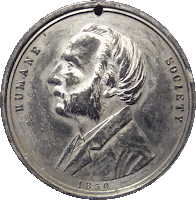Miscellaneous Award Medals
"The Great Medal of Honor" / Three Muses Medal
Aluminum, 51.12mm
| Probably unique. George H. used the reverse die on several other medals, especially Agricultural Society Award medals. In his book on Sage, Bowers notes that both dies are found combined with the obverse of the Elisha Kent Kane medal. These are listed in the Milford Haven catalog of British Naval medals. I have not seen either of these. |
Citizens of New York to Henry Grinnell Medal
Silver, 38mm
(image courtesy of John Sallay)
South Carolina SPCA Medals
Obverse: Inscription within band around THE S.C. SOCIETY FOR THE
PREVENTION OF CRUELTY TO ANIMAL with a small star between two
dots at top. In the center a man attempting to beat a horse drawing a cart,
and an angel with one raised hand and a word in the other.
Reverse: Clothed male bust with large sideburns to left, HUMANE to left,
SOCIETY to right, 1850 below.
White metal?, 40mm
Animal Society, founded in 1874, was originally called the South Carolina
Society for the Prevention of Cruelty to Animals. In 1880 it became what is
now The Charleston Humane Society. But neither of these dates fit the 1850
date on the reverse. And The Humane Society of the U.S. was not founded
until 1954. And who was the gentleman on the reverse.
An inquiry in the E-Sylum and information from Pete Smith has shed some
light on this. The first president of the Charleston Humane Society was
Professor Nathaniel Russell Middleton (1810-1890). His image below does
resemble the image on the medal. The date does still not fit but George H.
did have a proclivity for errors that he did not correct.
Obverse: same as above
Reverse: An oak wreath with a small wreath at the bottom and open
space in center, small LOVETT N.Y. at bottom
Aluminum?, 40mm
This example is the reason I am attributing these medals to George H. Lovett.
The oak wreath reverse is signed by him and seems to be a generic award
die he used on several occasions, two are pictured below. The question
still remains whether he was the engraver on the first medal or did he
later obtain the reverse die and was up to his usual habit of combining
dies and striking medals. If it is aluminum then it would have been struck
later than the first.
Obverse: Clothed male bust with large sideburns to left, HUMANE to left,
SOCIETY to right, 1850 below.
Reverse: LIFE / SAVING / BRIGADE on ribbon surrounded by a wreath
White metal, 40mm
George H. Lovett because of the obverse die. The reverse
die definitely has the look of his work also.
Thursday March 2, 1882













